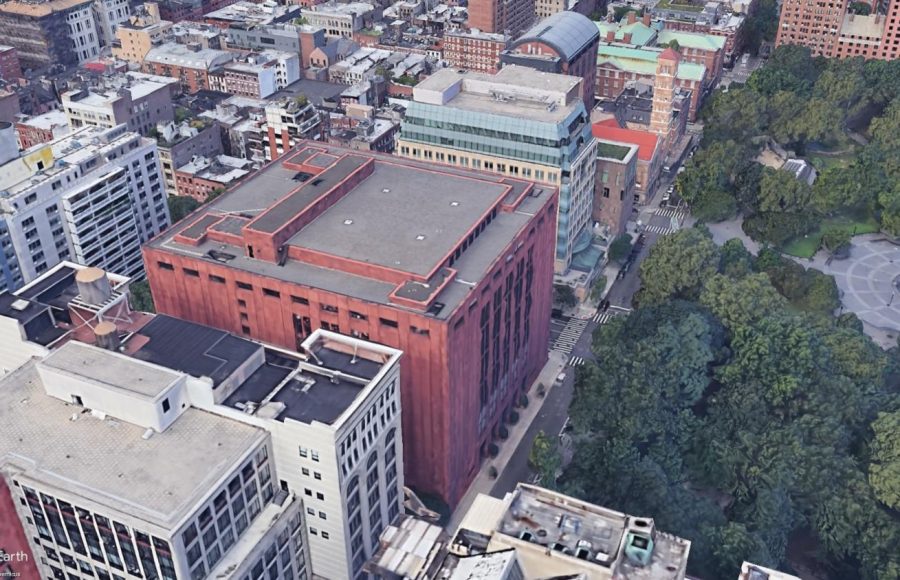NYU to install 304 solar panels atop Bobst
The university will finish installing the panels by the end of the semester as part of the university’s plan for carbon neutrality by 2040.
Bobst Library is located at 70 Washington Square S. NYU plans to install 304 solar panels by the end of the spring 2022 semester as part of the university’s sustainability initiative. (Image via Google/Landsat/Copernicus)
March 3, 2022
Bobst Library will be equipped with 304 solar panels as part of NYU’s push for greater sustainability, according to a February email from NYU president Andrew Hamilton. The solar panels will generate 110 kilowatts of energy for the library.
NYU Director of Energy Engineering Brian Burke said the installation of the solar panels is scheduled to finish by the end of the spring semester. The installation is one of the university’s latest efforts at transitioning toward clean energy. NYU plans to be carbon neutral by 2040, as part of its Climate Action Plan.
“Bobst was selected because it has the best solar access and the largest, unencumbered roof area,” Burke wrote in a statement to WSN. “The PV [photovoltaic] array will provide approximately 18% of Bobst’s power with the rest of the power being supplied by NYU’s cogeneration plant.”
NYU’s CoGeneration plant, located below Warren Weaver Hall, utilizes excess heat from other energy sources and provides both heating and cooling to 44 buildings and electricity to 26 buildings at NYU.
PV systems convert sunlight captured on solar panels into electrical power. The quantity of energy produced is dependent on the panels’ size and access to sunlight. The SunPower SPR-X22-360 solar panels will generate enough energy to power the Seventh Street residence hall and approximately 50 New York City homes for one year, according to Hamilton.
“Solar panels on campus are a step in the right direction since they are a renewable and clean source of electricity,” Cecil Scheib, NYU’s Chief Sustainability Officer, said in a statement to WSN. “Our dense, urban location generally means there’s a lot of shading from neighboring roofs, so it’s not always an option.”
NYU’s investments in fossil fuels, which have been a point of controversy among the student body, were also addressed by Hamilton, who said university investments that go indirectly into fossil fuel producers have been and will continue to decline over the next few years. He also said NYU does not and will not invest directly in companies that focus mainly on fossil fuel exploration and extraction.
Sunrise NYU, the university’s chapter of a student-led nationwide climate justice movement, launched a new NYU Divest campaign on Oct. 15, calling on the university to end all indirect investments in fossil fuels and private prisons.
Hamilton said in the email that NYU plans to increase investments in more renewable energy and carbon reduction technologies that increase the university’s sustainability efforts. He said the investments are dependent on the university’s endowment, which is worth around $5.8 billion as of August 2021.
CAS environmental science professor Christopher Schlottmann told WSN that he believes NYU has made progress in its sustainable operations since 2007. However, he said the university could improve its efforts to address the challenges of climate change and environmental injustice.
“Solarizing a fraction of our electricity is a step in that direction, as was minimizing fossil fuel investments,” Schlottmann wrote. “I hope to see NYU respond more proportionately, both in its operations (e.g., buildings), but also by building out our strongest assets: research and educational programs.”
NYU has made some progress in its sustainability practices since 2021: It saved 37 tons of carbon dioxide during the 2022 January term through a multi-school decrease in carbon footprint elements, according to Hamilton’s email. Actions taken include decreasing greenhouse gas emissions from food purchases by 8.3%, doubling the amount of bike racks on campus, and planning a $2 million sustainable remodel of Rubin Hall.
Burke said that a web portal is being designed for students to actively track how much energy is being produced in relation to the total power used by NYU buildings.
Contact Bella Ingber at [email protected].
























































































































































